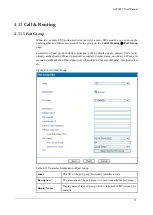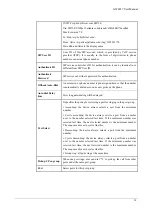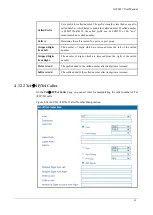
GW0017 User Manual
67
Community
Configuration
Community configuration exists in V1 and V2C.
Community:
fill in a community name used to read through SNMP protocol;
it is a character string.
Source:
The IP address of SNMP server.
SNMP server cannot identify the packets sent from GW0017 unless the
community configured in GW0017 matches with the community configured
in SNMP server.
Group
Configuration
Group configuration exists in V1 and V2C and V3.
Group:
fill in a group name which is used to identify the group; it’s a
character string.
Community:
fill in a community which means this community has joined in
the group.
In the following, access permission of read, write and notify is configured for
each group.
View
Configuration
View configuration exists in V1, V2C and V3.
ViewName:
fill in a view name which is used to identify this view.
ViewType:
choose ‘Included’ or ‘Excluded’. ‘Included’ means the view
includes the OID of the corresponding ViewSubtree, while ‘Excluded’ means
the OID of the corresponding ViewSubtree is excluded from this view.
ViewSubtree:
fill in the OID of the view subtree.
ViewMask:
it is used to withdraw a row of a table, such as an Ethernet port.
Access
Configuration
Access configuration exists in V1, V2C and V3, under which permission of
read, write or notify is configured for a community group.
Group:
choose a group name that has been configured.
Read:
Choose a ‘read’ view for the group.
Write:
Choose a ‘write’ view for the group.
Notify:
Choose a ‘notify’ view for the group.
Trap
Configuration
Trap configuration exists in V1, V2C and V3, which is aimed to send trap
alarm.
Trap Type:
Choose V1, V2C and Inform.
Trap IP:
the IP address of the destination SNMP server where trap alarm is
sent.
Trap Port:
the port of the destination SNMP server, which will receive trap
alarm.
Trap Community:
the community configured in the destination SNMP
server.
User
Configuration
User configuration exists in V3. When V3 transmits SNMP packets in an
encryption way, this item needs to be configured.
User:
fill in a user name used to authenticate.
AuthType:
choose MD5 or SHA as authentication type.
















































